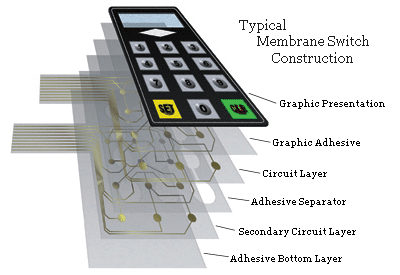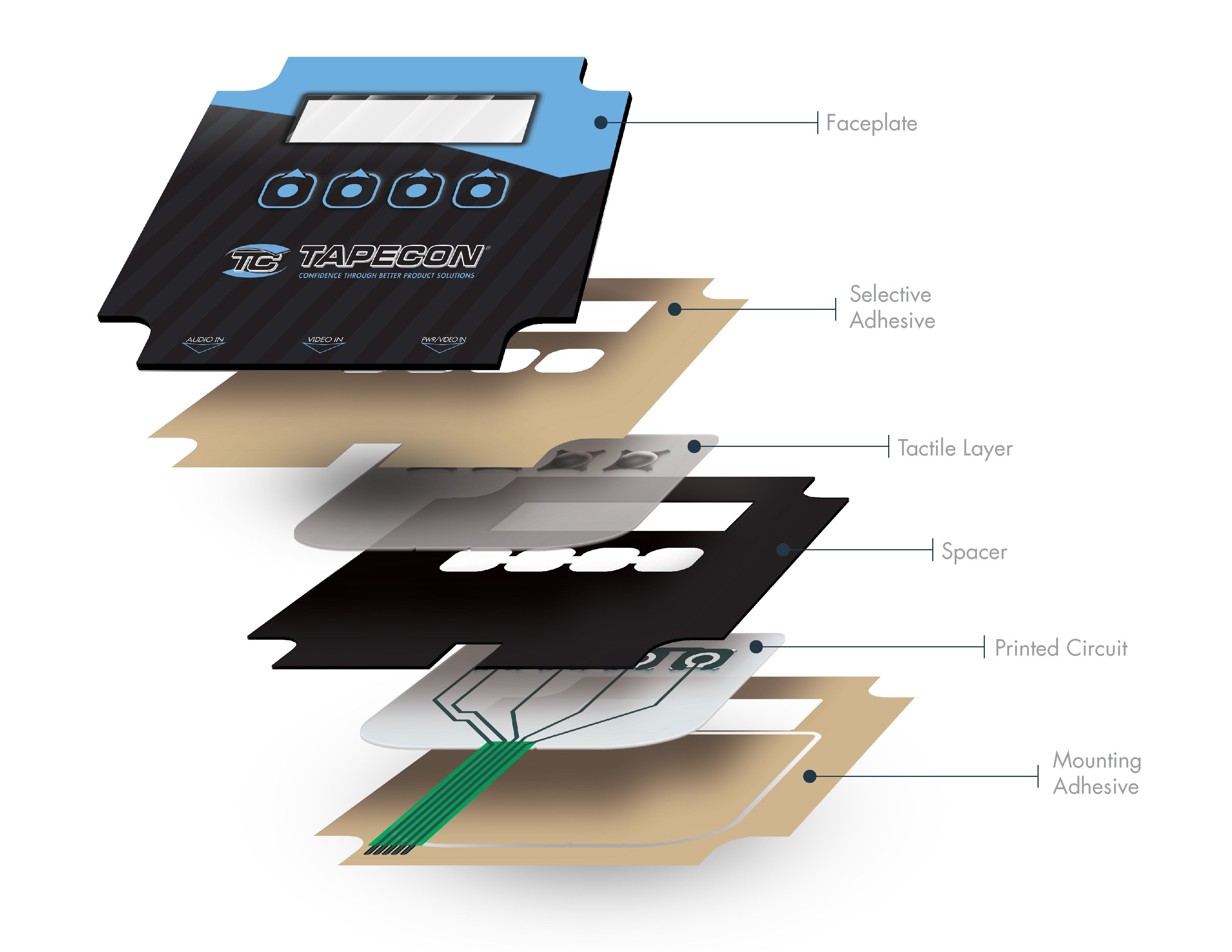The services offered by a specialized membrane switch manufacturer go beyond standard-level production.
The services offered by a specialized membrane switch manufacturer go beyond standard-level production.
Blog Article
Everything About Membrane Switch: Comprehending Its Design and Capability
When you consider the control interfaces in modern-day devices, membrane switches typically come to mind. These elements are greater than simply switches; they blend style and functionality effortlessly. Understanding how they function and what makes them effective can transform your perspective on daily electronics. Yet, there are subtleties to their design and efficiency that you might not understand. Allow's discover what sets membrane switches over apart from other control systems.
What Are Membrane Layer Switches?

Their seamless nature makes them easy to clean and immune to dust and wetness, a vital attribute in many environments. Membrane layer buttons can additionally be customized regarding form, size, and graphics, enabling manufacturers to develop one-of-a-kind interfaces tailored to particular products. Plus, they're lightweight and slim, which aids in reducing the total mass of tools. On the whole, membrane layer buttons play a significant function in boosting customer experience across a vast range of applications.
Just How Membrane Layer Switches Work
When you press a key on a membrane switch, it turns on an uncomplicated yet efficient device. The top layer, frequently made from versatile product, presses down onto a conductive layer beneath it. This action bridges the void in between conductive traces, finishing an electrical circuit. As quickly as the circuit shuts, it sends a signal to the tool's controller, which translates your input.
You'll see that the responsive comments differs based upon the switch layout, offering either a soft click or a much more pronounced response. As soon as you release the key, the membrane layer go back to its original placement, reopening the circuit and stopping the signal. This process occurs nearly instantaneously, ensuring a responsive individual experience.
Membrane switches are preferred because of their toughness and resistance to dust and moisture, making them suitable for various applications, from house appliances to medical devices. Understanding this procedure assists you appreciate their extensive use.
Secret Components of Membrane Buttons
Recognizing the vital parts of membrane layer buttons is fundamental for realizing their functionality and design. At the core, you'll discover the visuals overlay, which offers the aesthetic user interface for customers. Underneath that, there's a spacer layer that separates the circuit layers, making sure that they do not make get in touch with until pushed. The circuit layer is where the magic occurs; it includes conductive traces that finish the circuit when you push the switch. Another essential component is the adhesive support, permitting the button to stick to surface areas firmly. The safety layer shields against ecological aspects and use, extending the switch's life-span. Each element plays a considerable function in guaranteeing trusted performance and customer communication. By comprehending these components, you'll gain understanding into how membrane layer switches over run and their relevance in numerous applications.
Materials Used in Membrane Change Style
The efficiency and sturdiness of membrane switches greatly rely on the products utilized in their design. You normally encounter polyester and polycarbonate as main substratums because of their exceptional strength and adaptability. These materials stand up to scrapes and chemicals, making them perfect for requiring settings.
The conductive layers frequently make use of silver or carbon, selected for their reliability and conductivity. membrane switch manufacturer. Silver gives exceptional efficiency, while carbon is an affordable choice. For the overlay, you might take into consideration a matte or shiny finish, depending upon your aesthetic requirements and customer experience
Make certain to pick adhesives that endure ecological elements like temperature and humidity. Picking the appropriate products will certainly assure your membrane layer switch stands the test of time.
Layout Considerations for Membrane Layer Buttons
While creating membrane layer buttons, it's important to take right into account various factors that influence their performance and user experience. Beginning by concentrating on the design and switch size; make specific they're instinctive and easy to browse.
Validate your design suits environmental variables, like moisture or temperature level variations, which could impact performance. By thoroughly thinking about these aspects, you'll develop a membrane layer button that improves functionality and fulfillment.
Applications of Membrane Switches
Membrane switches are versatile parts discovered in numerous applications, from commercial devices to customer electronics. You'll see their impact in equipments that call for sturdy user interfaces and in gadgets that benefit from smooth layouts. Recognizing these applications assists you value the performance and practicality of membrane buttons in everyday innovation.
Industrial Equipment Usage
When you're looking to enhance the performance of industrial equipment, membrane switches supply a reputable remedy that combines toughness with user-friendly design. These switches are ideal for extreme settings, giving resistance to dirt, moisture, and chemicals. Embrace membrane buttons to enhance your procedures and enhance general efficiency.
Consumer Electronics Integration
In the domain of customer electronic devices, membrane layer switches play a necessary duty in boosting customer communication and tool performance. You'll locate them in devices like microwaves, remote controls, and pc gaming consoles, offering a seamless method to communicate with modern technology. Their smooth layout enables simple combination you could look here right into different items, making controls user-friendly and straightforward. With their ability to incorporate graphics and backlighting, you can enjoy a modern-day visual that matches the tool's general appearance. Membrane buttons likewise ensure durability and resistance to dirt and dampness, expanding the lifespan of your electronic devices. By selecting membrane buttons, you improve not just the functionality however also the design of your gadgets, making day-to-day communications smooth and enjoyable.
Benefits and Negative Aspects of Membrane Buttons
While membrane switches provide an array of benefits, they additionally come with some drawbacks that you ought to take into Discover More consideration. One considerable advantage is their portable design, making them ideal for space-constrained applications. They're likewise cost-efficient, offering a durable remedy with a reduced manufacturing price. On top of that, their smooth surface area is easy to clean, boosting hygiene in atmospheres like medical facilities.

Membrane switches can have a much shorter life-span compared to mechanical buttons, especially under hefty usage. They can also be less responsive, which could affect user responses during operation. Balancing these pros and cons will help you identify if membrane layer buttons are the best fit for your project.
Regularly Asked Inquiries
How Long Do Membrane Layer Changes Normally Last?
Membrane layer changes commonly last between 5 to one decade, depending on usage and ecological conditions. You'll desire to assess aspects like wear, direct exposure to wetness, and temperature changes to evaluate their long life successfully.
Can Membrane Changes Be Custom-made for Specific Styles?
Yes, you can tailor membrane layer buttons to fit specific styles (membrane switch manufacturer). You'll have the liberty to choose colors, shapes, and layouts that match your project's demands, guaranteeing they mix seamlessly with your general visual
What Is the Cost Variety for Membrane Layer Change Manufacturing?
The Find Out More cost variety for membrane button manufacturing commonly drops between $1 and $10 per unit, depending upon variables like style intricacy, quantity, and products. You can obtain quotes from makers to find the very best choice.

Are Membrane Layer Switches Over Water Resistant or Immune?
Membrane layer buttons can be made to be waterproof or immune, relying on products utilized and construction techniques. If you need them for damp environments, assure you specify those requirements during the design process.
Just How Do Membrane Switches Contrast to Standard Buttons?
Membrane layer buttons are generally thinner and more flexible than traditional buttons, supplying a streamlined style. They're frequently simpler to clean up and integrate, but might not provide the responsive responses you're utilized to with mechanical choices.
Conclusion

Report this page